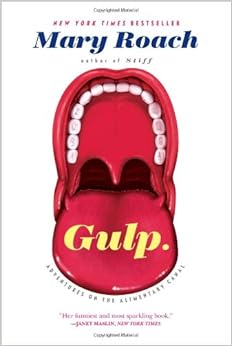 Gulp: Adventures on the Alimentary Canal is Mary Roach's 2013 release about food and its journey from start to finish. Here, Roach brings her trademark style – combining interviews and site visits with interesting vignettes. She is never afraid of the taboo (Ed Yong has said he has the "wow" beat in science writing; I think Mary Roach has the "ick" beat) and the subject of the physical process of eating and digestion is rife with such topics. Roach states that books about cuisine and food have eclipsed books about the process of eating, which serves her well because most of the interesting stories about digestion are untold.
Gulp: Adventures on the Alimentary Canal is Mary Roach's 2013 release about food and its journey from start to finish. Here, Roach brings her trademark style – combining interviews and site visits with interesting vignettes. She is never afraid of the taboo (Ed Yong has said he has the "wow" beat in science writing; I think Mary Roach has the "ick" beat) and the subject of the physical process of eating and digestion is rife with such topics. Roach states that books about cuisine and food have eclipsed books about the process of eating, which serves her well because most of the interesting stories about digestion are untold. One of these strange tidbits is that different animals perceive tastes differently. Catfish have taste receptors all over their skin, effectively making them "swimming tongues"; this also makes catfish a popular model organism for taste researchers. Flies taste with their feet. Humans have taste receptors in the gut and the esophagus as well as the tongue; luckily, only the receptors on the tongue are transmitted to the brain. Animals also have different preferences for tastes: rodents love sweetness, but cats cannot perceive sweet tastes. Dogs' tastes are driven by their sense of smell and they show a strong preference for things that smell like cadaverine or putrescine, odors emitted by decaying meat. Dog food manufacturers often use these scents – in concentrations perceptible to your dog but not to you – to increase a dog's interest in the food. Roach visits a pet food manufacturer and watches dogs taste testing dog food, which gives a fascinating behind-the-scene glimpse of the industry.
 |
| Beaumont studying the digestion of his patient, St. Martin |
I also learned some surprising facts about saliva. For one, the main digestive enzyme in saliva is amylase, which breaks down starches into simple sugars. This activity makes amylase an excellent way to treat food stains on clothing. Laundry detergents often contain at least three digestive enzymes: amylase to break down starchy stains, lipase for greasy stains, and protease to break down protein. It's good to know that there is a scientific basis to my instinct to spit on food stains.
The other interesting elements in the book are learning the techniques that scientists are using to study eating, digestion, and defecation. Roach visits labs that study topics like the function and components of saliva, the process of chewing, and the chemical composition of flatulence. Unfortunately, I felt that these serious topics were often glossed over for the sake of a punchline. I do find Roach's work easy to read, but her sense of humor does not always mesh with mine. I knew that talking about the journey that food takes from beginning to end would bring out her obsession with the scatological and yet I plowed through. I suppose I'm glad I did, as the penultimate chapter discussed Elvis Presley's digestive troubles; Elvis suffered from mega-colon, which was likely a confounding factor in his death. It's funny that my favorite Mary Roach book is Stiff: The Curious Lives of Human Cadavers (I admit to reading it after seeing it on Six Feet Under), which somehow seems less gross than this one. In the end, I would only recommend reading Gulp if you like Mary Roach's approach to science writing.
No comments:
Post a Comment
Note: Only a member of this blog may post a comment.